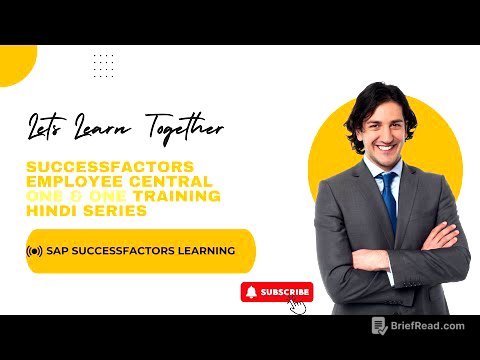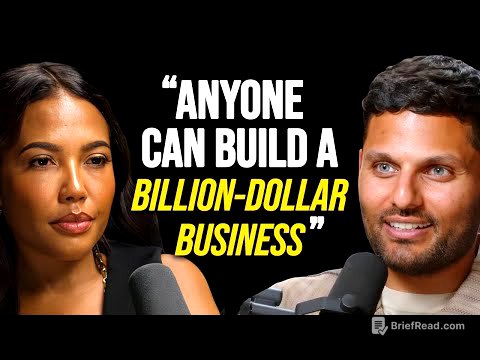TLDR;
Simon Sinek's "Start With Why" explores how inspirational leaders and organisations think, act, and communicate in a way that is the opposite of everyone else. He introduces the Golden Circle model (Why, How, What) to explain why some organisations are able to inspire more than others. The key takeaway is that people don't buy what you do; they buy why you do it. This concept is rooted in biology, aligning with the three major components of the brain. By communicating from the inside out (Why, How, What), you directly influence the part of the brain that controls behaviour and decision-making.
- The Golden Circle: Why, How, What
- People buy why you do it, not what you do
- Communicate from the inside out to inspire
Introduction: The Power of "Why" [0:02]
Simon Sinek begins by questioning why some organisations, like Apple, are consistently more innovative than their competitors, despite having the same resources. He also asks why leaders like Martin Luther King led the Civil Rights Movement and why the Wright brothers achieved controlled, powered flight when others were better qualified and funded. Sinek suggests that there's a pattern among great, inspiring leaders and organisations: they all think, act, and communicate in the same way, which is the opposite of how most others do.
The Golden Circle: Why, How, What [2:12]
Sinek introduces the Golden Circle, comprising three levels: Why, How, and What. Every organisation knows what they do, and some know how they do it (their differentiated value proposition). However, very few know why they do what they do, which refers to their purpose, cause, or belief. He emphasises that "why" is not about making a profit, but about the organisation's reason for existence. Most communicate from the outside in (What, How, Why), but inspired leaders and organisations communicate from the inside out (Why, How, What).
Apple's Communication Strategy [3:25]
Sinek uses Apple as an example to illustrate the power of communicating from the inside out. Instead of saying, "We make great computers that are beautifully designed and user-friendly," Apple communicates their core belief: "Everything we do, we believe in challenging the status quo. We believe in thinking differently." They then explain how they challenge the status quo by making beautifully designed, simple-to-use products. This approach demonstrates that people buy why you do it, not what you do. This is why people are comfortable buying various products from Apple, even though they are just a computer company.
The Biology of Why: How the Brain Works [5:51]
Sinek explains that his ideas are grounded in biology, not psychology. The human brain is divided into three major components that align with the Golden Circle. The neocortex corresponds to the "what" level and is responsible for rational and analytical thought and language. The limbic brains correspond to the "how" and "why" levels and are responsible for feelings like trust and loyalty, as well as all human behaviour and decision-making, but has no capacity for language. Communicating from the inside out speaks directly to the part of the brain that controls behaviour, allowing people to rationalise decisions with tangible facts.
The Wright Brothers vs. Samuel Pierpont Langley [8:14]
Sinek contrasts the Wright brothers with Samuel Pierpont Langley to further illustrate the importance of "why". Langley, who was well-funded and had the best resources, failed to achieve powered flight because he was motivated by fame and fortune. The Wright brothers, driven by a belief that their flying machine could change the world, succeeded despite lacking resources and formal education. Their team worked with passion and dedication because they believed in the cause, while Langley's team worked for a paycheck.
The Law of Diffusion of Innovation [11:01]
Sinek introduces the law of diffusion of innovation, which categorises people into innovators, early adopters, early majority, late majority, and laggards. To achieve mass-market success, you need to reach a tipping point of 15-18% market penetration. Innovators and early adopters make intuitive decisions based on their beliefs, while the early majority waits for others to try something first. People buy what you do, and what you do proves what you believe.
TiVo vs. Martin Luther King Jr.: Success and Failure [13:37]
Sinek presents TiVo as a commercial failure despite having a high-quality product and ample funding. TiVo focused on what they did (pausing live TV, skipping commercials) instead of why they did it. In contrast, Martin Luther King Jr. inspired 250,000 people to attend his speech in Washington by communicating what he believed, not what needed to change. People who believed what he believed took his cause as their own. King gave the "I have a dream" speech, not the "I have a plan" speech, inspiring people to follow him not for his sake, but for their own beliefs.
Leadership and Inspiration [17:20]
Sinek concludes by distinguishing between leaders (those with power or authority) and those who lead (those who inspire). People follow those who lead because they want to, not because they have to. Those who start with "why" have the ability to inspire others and find those who inspire them.









